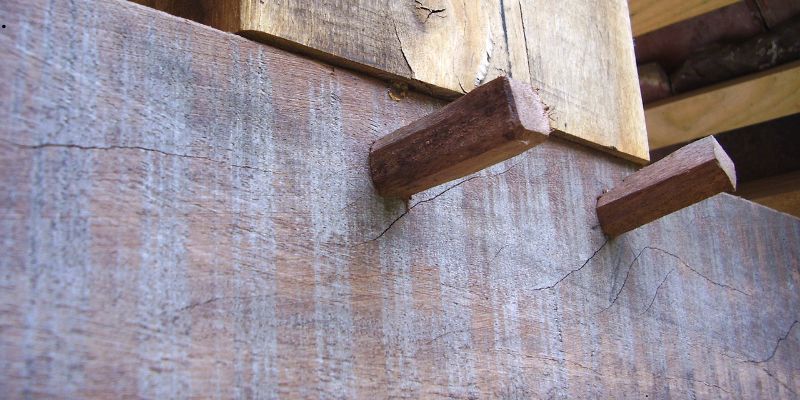Dowel Joints vs. Biscuit Joints: Which Should You Use?
Dowel Joints guide for stronger woodworking connections

Choosing the right joint can make all the difference in how strong and long-lasting your project turns out. Two popular methods, dowel joints and biscuit joints, are often the go-to options for woodworkers.
But how do you know which one to use? By understanding what each method offers and where it shines, you can make an informed choice and achieve professional results.
Let's break down the basics of dowel and biscuit joints to help you decide.
What Are Dowel Joints?
A dowel joint uses wooden pins, or "dowels," to connect two pieces of wood. You drill matching holes in both pieces, insert the dowels with glue, and fit everything together. It’s like using wooden nails, but the dowels remain hidden inside the joint.
Why Choose Dowel Joints?
- Built to Last
Dowel joints are known for their durability. The glue and snug fit create a bond that can handle heavy loads and last for years. These are perfect for stress-heavy applications like chair frames or table legs. - Seamless Design
Done correctly, dowels leave no visible signs of the joinery, letting the beauty of the wood take center stage. - Versatile Uses
From simple edge-to-edge joints to complicated angled pieces, dowel joints can adapt to almost any woodworking need. - A Nod to Traditional Crafting
With centuries of history behind them, dowel joints connect you to the time-honored methods of skilled woodworkers.
Challenges
- Needs Precision
Misaligned holes can ruin the entire joint. Accurate measuring and drilling are essential. - Takes Time
Setting up tools and aligning holes means this approach isn’t the quickest option. - Specialized Tools Required
You’ll need doweling jigs and drill bits made specifically for this type of joinery.
What Are Biscuit Joints?
On the other hand, biscuit joints rely on flat, oval-shaped wooden pieces called "biscuits." A biscuit joiner cuts slots into the wood where the biscuits fit. When combined with glue, the biscuits swell slightly, forming a tight bond.
Why Choose Biscuit Joints?
- Fast and Simple
A biscuit joiner is quick to set up, making this method a time-saver. If you're working on multiple joints in a single session, biscuits help you finish faster. - Easy Alignment
Biscuits naturally align boards during glue-ups, making them beginner-friendly and forgiving of small errors. - Great for Wide Boards
Joining boards edge-to-edge for things like tabletops or cabinet doors is where biscuit joints really shine. - Best for Speedy Projects
If you're short on time, biscuit joints are an excellent choice.
Challenges
- Not as Strong
While strong enough for most jobs, biscuit joints don’t match dowels when it comes to handling heavy loads or stress. - Limited Versatility
Biscuit joints excel at edge-to-edge connections but aren’t practical for more complicated shapes or smaller pieces of wood. - Dependency on Tools
You'll need a biscuit joiner, a niche tool designed for this type of joint.
Dowel Joints vs. Biscuit Joints: Head-to-Head
To pick the right joint, it helps to compare them based on key factors:
Strength
If you need maximum holding power, dowel joints are the clear winner. They provide a wood-to-wood bond and a larger glue surface area.
Best for: Furniture like chairs and beds, or projects that take a lot of wear and tear.
Ease of Use
Biscuit joints are much easier for beginners. They’re forgiving and self-aligning, requiring less precision compared to dowel joints.
Best for: New woodworkers learning the ropes, or anyone doing simple projects like panel glue-ups.
Efficiency
Biscuit joints are faster and require fewer setup steps. If speed matters, biscuits are the way to go.
Best for: Quick projects or production-style woodworking.
Versatility
Dowel joints offer more flexibility. Whether you’re tackling complex angles or joining thin pieces, dowels adapt to scenarios where biscuits can’t.
Best for: Intricate work or pieces requiring precise, strong joins.
Tips for Choosing the Right Joint
Use Dowel Joints When:
- You’re working on pieces that will bear a lot of weight or stress.
- The joinery will be visible, and you want a clean, sleek finish.
- You’re building something traditional or historically inspired.
- The project involves thin or angled wood that can’t accommodate a biscuit slot.
Use Biscuit Joints When:
- You need to join the wide boards or panels.
- The timeline is tight, and you need a fast solution.
- You’re just starting out and want a simple, safe method.
- You’re producing multiple, identical parts efficiently.
Final Thoughts
So, dowel or biscuit joints? Think about the job at hand, what are your priorities? Strength? Speed? Simplicity? With a clear understanding of your project’s needs, picking the right method becomes much easier.
If you’re just starting out, biscuits give you a manageable entry point into joinery. But as your skills grow, learning dowel joints will expand what you can achieve.
Practice makes perfect, so don’t be afraid to test each method on scrap wood before starting a big project. A strong, well-executed joint is not just about the tools you use but the care and precision you bring to the craft. At Bay & Bent, we know that every piece of wood tells a story. With the right tools and techniques, your woodworking projects can tell a story of excellence and artistry, too.









